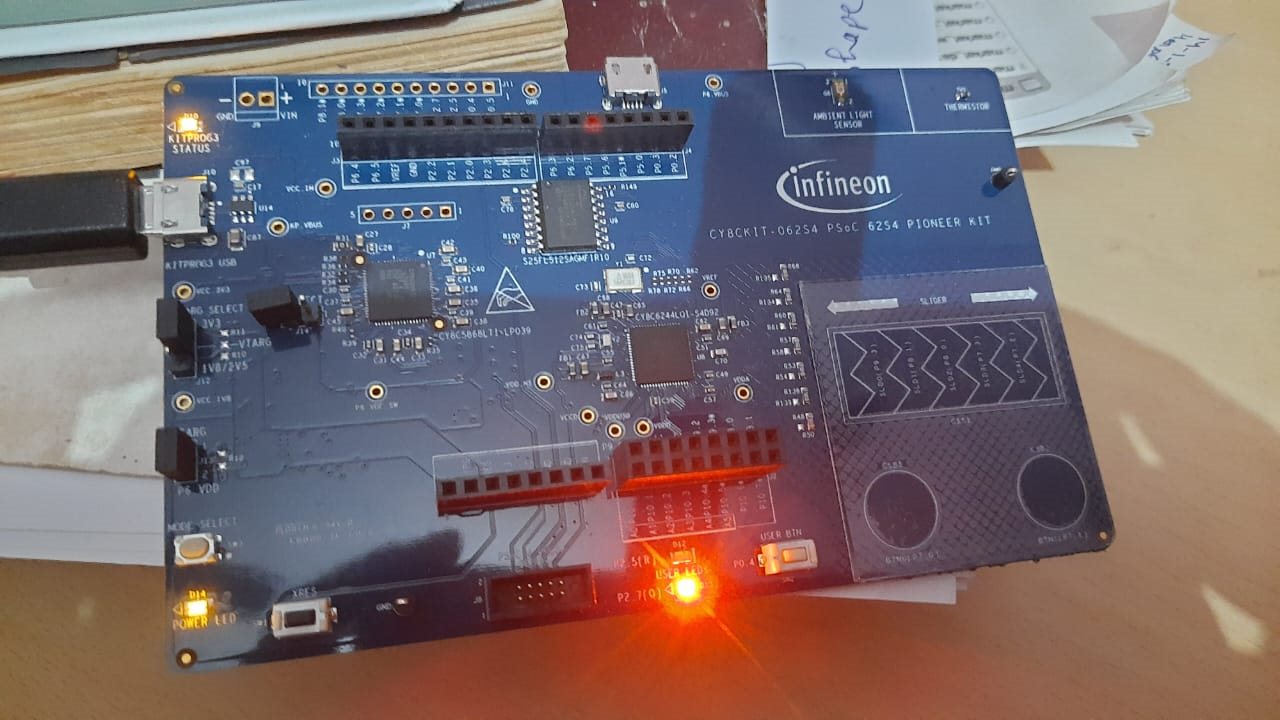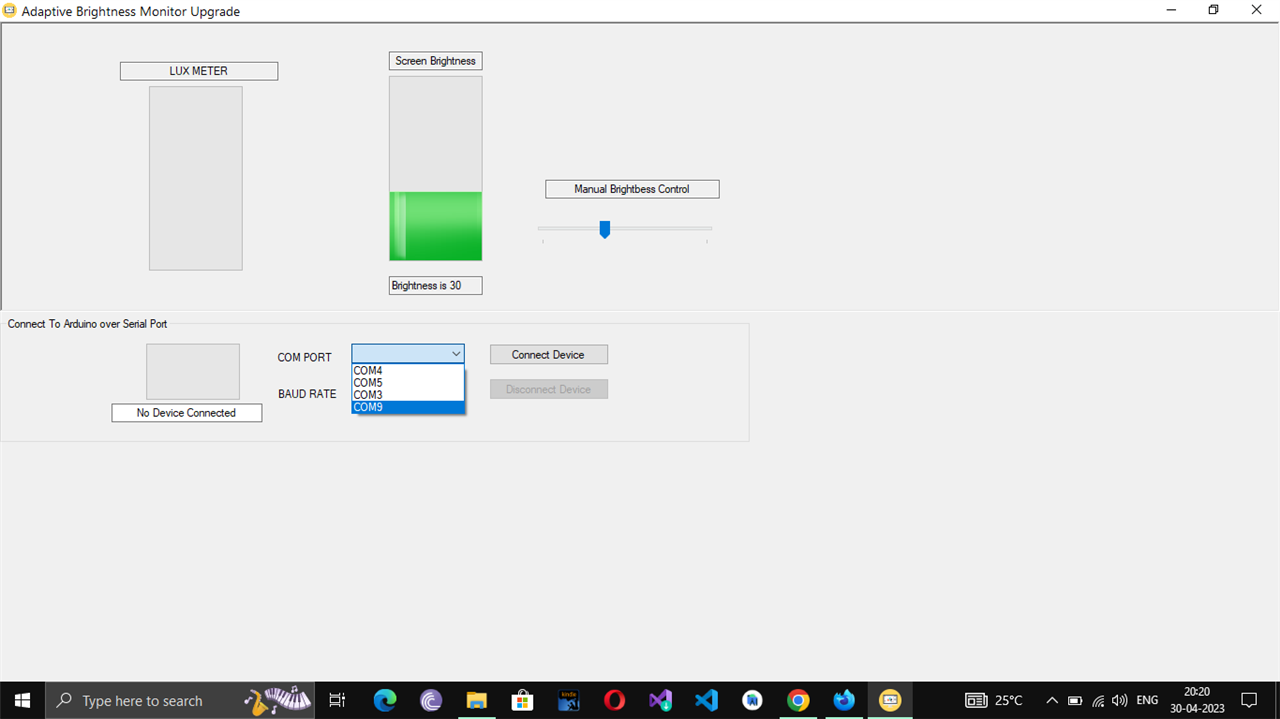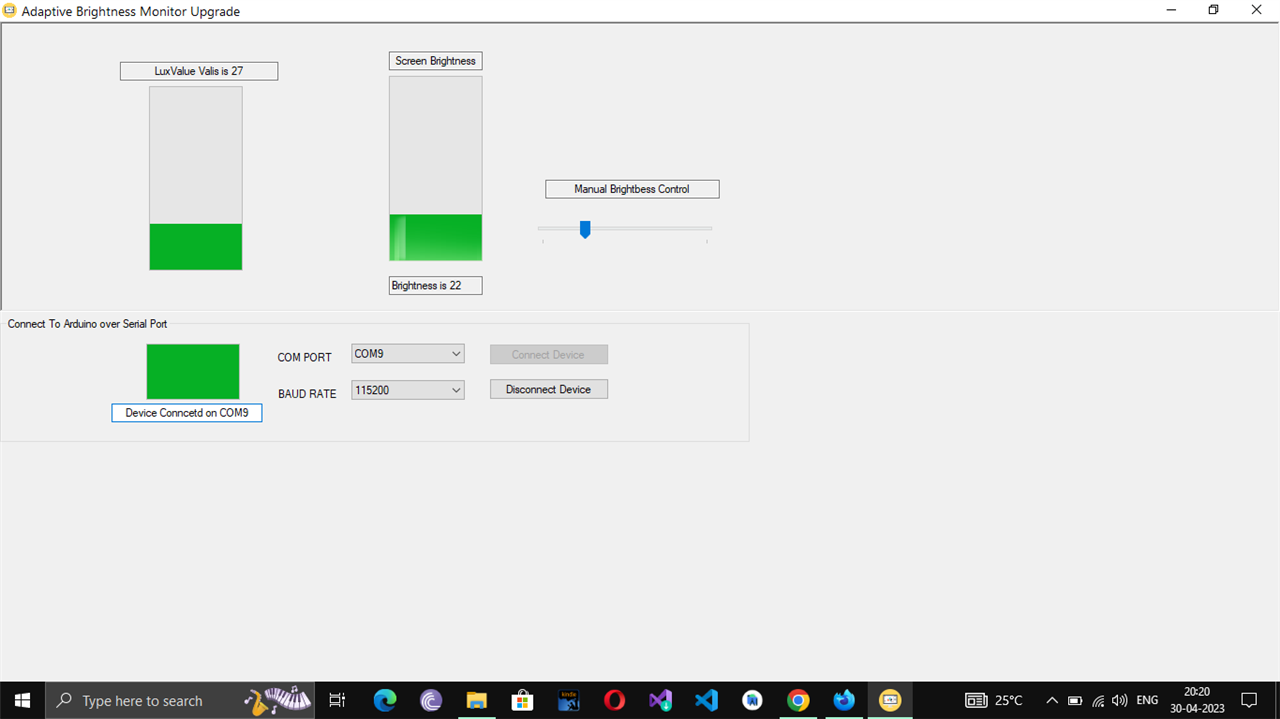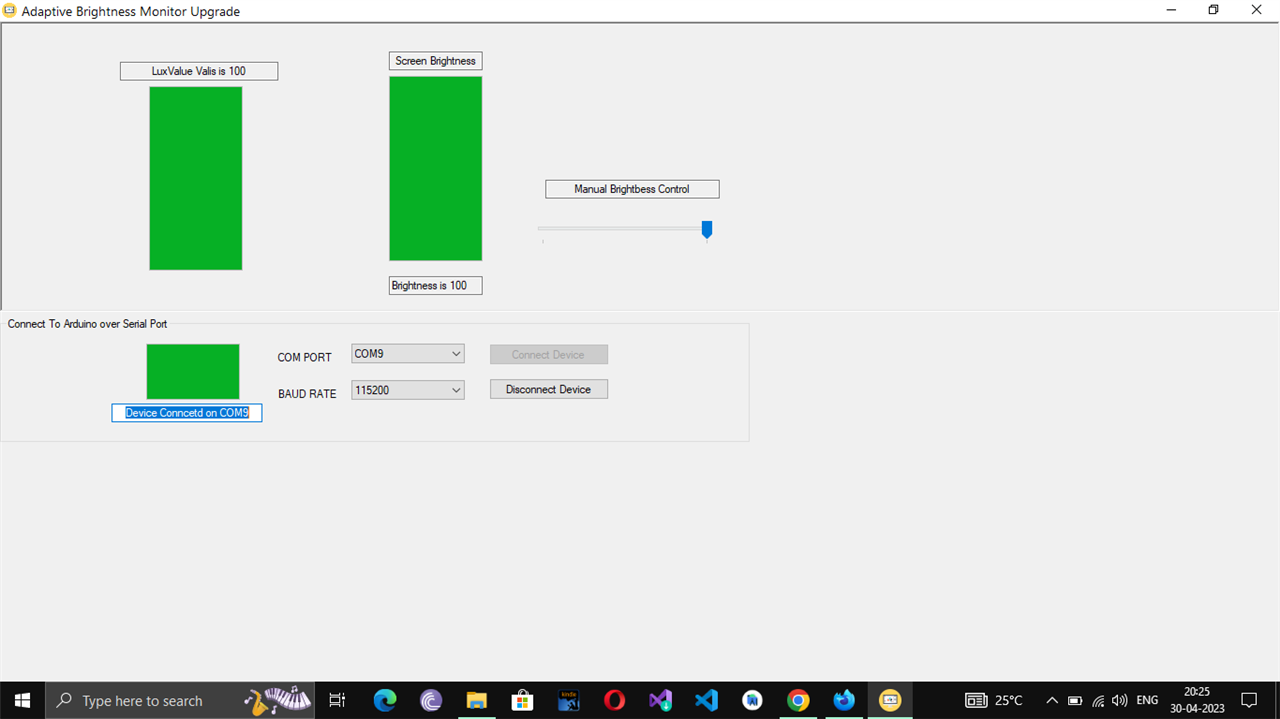Introduction Welcome to the final part of our series on building an adaptive brightness feature to protect your eyes from strain and fatigue. In the previous article, we discussed the implementation of code on PSoCTm 62S4 pioneer kit (CY8CKIT-062S4). In this article, we will be discussing the final part of the project which is PC brightness control.
As we know, prolonged exposure to bright screens can cause eye strain, fatigue, and other eye-related problems. To prevent these problems, we need a system that can adjust the screen brightness based on the ambient light level in the room. In the previous articles, we discussed the hardware and software requirements for this system, and we have successfully implemented the code on the PSoCTm 62S4 pioneer kit.
Now, let's move on to the final part of the project which is PC brightness control. The PC brightness control involves the integration of the hardware and software components to adjust the screen brightness based on the ambient light level in the room. To implement the PC brightness control system, we developed a visual studio program that takes ambient light level from PSoCTm 62S4 pioneer kit over serial port as Input and adjust screen brightness according to it.
Procedure to Control: Connect PSoCTm 62S4 pioneer kit to pc over usb

open AdaptiveBrightnessMonitorUpgrade.exe

Select COM Port at which pioneer kit is connected and click on "Connecct Device"

As the Kit will be connected it will be shown connected on com port

Now automatically on increasing the ambient light levels it increases screen brightness and on low light conditions it reduces screen brightness to reduce eye strain


we can click on disconnect device to stop this if needed and adjust brightness manually also with slider provided
You can download the files from here
7180.SourceCodeAdaptiveBrightnessMonitorUpgrade62S4.rar
8883.AdaptiveBrightnessMonitorUpgradeSoftwarefile.rar
/******************************************************************************
* File Name: main.c
*
* Description: This is the source code for the PSoC 6 MCU SAR ADC Low-Power
* Sensing - Ambient Light Levels
*
*******************************************************************************/
#include "cy_pdl.h"
#include "cyhal.h"
#include "cybsp.h"
#include "cy_retarget_io.h"
#include "math.h"
/*******************************************************************************
* Macros
********************************************************************************/
/* Defines for the ADC channels */
#define THERMISTOR_SENSOR_CHANNEL (1)
#define REF_RESISTOR_CHANNEL (0)
#define ALS_SENSOR_CHANNEL (2)
/* Number of channels used */
#define CHANNEL_COUNT (3)
/* Reference resistor in series with the thermistor is of 10kohm */
#define R_REFERENCE (float)(10000)
/* Beta constant of NCP18XH103F03RB thermistor is 3380 Kelvin. See the thermistor
data sheet for more details. */
#define B_CONSTANT (float)(3380)
/* Resistance of the thermistor is 10K at 25 degrees C (from the data sheet)
Therefore R0 = 10000 Ohm, and T0 = 298.15 Kelvin, which gives
R_INFINITY = R0 e^(-B_CONSTANT / T0) = 0.1192855 */
#define R_INFINITY (float)(0.1192855)
/* Zero Kelvin in degree C */
#define ABSOLUTE_ZERO (float)(-273.15)
/* ALS offset in Percent */
/* To configure this value, begin with offset of 0 and note down the lowest ALS
percent value. Configure the ALS_OFFSET with the lowest observed ALS percent. */
#define ALS_OFFSET (20)
/* ALS low threshold value - if ALS percentage is lower than this value, user
* LED is turned ON */
#define ALS_LOW_THRESHOLD (45)
/* ALS high threshold value - if ALS percentage is higher than this value, user
* LED is turned OFF */
#define ALS_HIGH_THRESHOLD (55)
/*******************************************************************************
* Function Prototypes
********************************************************************************/
/* Function to convert the measured voltage in the thermistor circuit into
* temperature */
double get_temperature(int32 therm_count, int32 ref_count);
/* Function to convert the measured voltage in the ALS circuit into percentage */
uint8 get_light_intensity(int32 adc_count);
/* IIR Filter implementation */
int32 low_pass_filter(int32 input, uint8 data_source);
/* FIFO Interrupt Handler */
void sar_fifo_interrupt_handler(void);
/* Function to initialize analog resources */
/* Resources include SAR ADC and its associated FIFO, analog references and
deep sleep resources */
void init_analog_resources(void);
/*******************************************************************************
* Global Variables
********************************************************************************/
/* IIR Filter variables */
int32 filt_var[CHANNEL_COUNT];
/* FIFO interrupt configuration structure */
/* Source is set to FIFO 0 and Priority as 7 */
const cy_stc_sysint_t fifo_irq_cfg = {
.intrSrc = (IRQn_Type) pass_interrupt_fifo_0_IRQn,
.intrPriority = 7
};
/* This flag is set in the FIFO interrupt handler */
volatile uint8 fifo_intr_flag = false;
/*******************************************************************************
* Function Name: main
********************************************************************************
* Summary:
* This is the main function for CM4 CPU. It initializes the ADC, does the
* measurement of thermistor and ALS and sends the data over UART.
*
* Parameters:
* void
*
* Return:
* int
*
*******************************************************************************/
int main(void)
{
/* Configure P6[5] - JTAG Data to Analog High Z to avoid leakage current */
/* This pin is logic high by default which causes leakage current on CY8CKIT-062S4 Pioneer Kit. */
cyhal_gpio_configure(P6_5, CYHAL_GPIO_DIR_OUTPUT, CYHAL_GPIO_DRIVE_ANALOG);
/* Variable to capture return value of functions */
cy_rslt_t result;
/* FIFO read structure */
cy_stc_sar_fifo_read_t fifo_data = {0};
/* Variable for filtered reference voltage (thermistor circuit) and als data */
int32 filtered_data[CHANNEL_COUNT];
/* Temperature value in deg C */
double temperature;
/* Light intensity in percentage */
uint8 light_intensity;
/* Variable to initialize IIR filter for the first iteration */
uint8 first_run[CHANNEL_COUNT]= {true, true, true};
/* Variable for number of samples accumulated in FIFO */
uint8 data_count;
uint16 display_delay = 0;
/* Initialize the device and board peripherals */
result = cybsp_init() ;
if (result != CY_RSLT_SUCCESS)
{
CY_ASSERT(0);
}
/* Initialize the debug uart */
result = cy_retarget_io_init(CYBSP_DEBUG_UART_TX, CYBSP_DEBUG_UART_RX,
CY_RETARGET_IO_BAUDRATE);
if (result != CY_RSLT_SUCCESS)
{
CY_ASSERT(0);
}
/* Print message */
/* \x1b[2J\x1b[;H - ANSI ESC sequence for clear screen */
printf("\x1b[2J\x1b[;H");
printf("---------------------------------------------------------------------------\r\n");
printf("PSoC 6 MCU: SAR ADC Low-Power Sensing - Thermistor and Ambient Light Sensor\r\n");
printf("---------------------------------------------------------------------------\r\n\n");
printf("Touch the thermistor and block/increase the light over the ambient light \r\n");
printf("sensor to observe change in the readings. \r\n\n");
/* Initialize and enable analog resources */
init_analog_resources();
/* Configure the LED pin */
result = cyhal_gpio_init(CYBSP_USER_LED2, CYHAL_GPIO_DIR_OUTPUT , CYHAL_GPIO_DRIVE_STRONG, CYBSP_LED_STATE_OFF);
if (result != CY_RSLT_SUCCESS)
{
CY_ASSERT(0);
}
/* Enable the global interrupt */
__enable_irq();
/* Enable the timer to start the sampling process */
/* Using the device configurator, trigger interval from the timer is
* set to 2.5ms which results in effective scan rate of 400sps for the SAR ADC.
*/
Cy_SysAnalog_TimerEnable(PASS);
for (;;)
{
/* Wait till printf completes the UART transfer */
while(cyhal_uart_is_tx_active(&cy_retarget_io_uart_obj) == true);
/* Put the device to deep-sleep mode. Device wakes up with the level interrupt from FIFO.
With the effective scan rate of 400sps, level count of 120 and 3 channels, device
wakes up every 120/(400*3) seconds, that is, 100ms. */
Cy_SysPm_CpuEnterDeepSleep(CY_SYSPM_WAIT_FOR_INTERRUPT);
/* Check if the interrupt is from the FIFO */
if(fifo_intr_flag)
{
/* Clear the flag */
fifo_intr_flag = false;
/* Check how many entries to be read. Should be equal to (LEVEL+1) when level
* interrupt is enabled */
data_count = Cy_SAR_FifoGetDataCount(SAR0);
/* Take all the readings from the FIFO and feed through IIR Filter */
while(data_count > 0)
{
data_count--;
/* Read the FIFO */
Cy_SAR_FifoRead(SAR0, &fifo_data);
/* If it is the first time reading the data, initialize the IIR filter
* variable and result variable */
if(first_run[fifo_data.channel] == true)
{
filtered_data[fifo_data.channel] = fifo_data.value;
filt_var[fifo_data.channel] = fifo_data.value << 8;
/* Clear the flag */
first_run[fifo_data.channel] = false;
}
else /* Push the data to the IIR filter */
filtered_data[fifo_data.channel] = low_pass_filter((int16)fifo_data.value, fifo_data.channel);
}
/* Calculate the temperature value */
temperature = get_temperature(filtered_data[THERMISTOR_SENSOR_CHANNEL], filtered_data[REF_RESISTOR_CHANNEL]);
/* Calculate the ambient light intensity in percentage */
light_intensity = get_light_intensity(filtered_data[ALS_SENSOR_CHANNEL]);
/* Control the LED */
if(light_intensity < ALS_LOW_THRESHOLD)
cyhal_gpio_write(CYBSP_USER_LED2, CYBSP_LED_STATE_ON);
else
if(light_intensity > ALS_HIGH_THRESHOLD)
cyhal_gpio_write(CYBSP_USER_LED2, CYBSP_LED_STATE_OFF);
/* Send over UART every 500ms */
if(display_delay == 4)
{
/* Print the the ambient light value*/
printf("%d\r\n", light_intensity);
/* Clear the counter */
display_delay = false;
}
else /* Increment the counter */
display_delay++;
}
}
}
/*******************************************************************************
* Function Name: init_analog_resources
********************************************************************************
* Summary:
* This function initializes the analog resources such as SAR ADC, reference block,
* and deep sleep resources.
*
* Parameters:
* None
*
* Return:
* None
*
*******************************************************************************/
void init_analog_resources()
{
/* Variable to capture return value of functions */
cy_rslt_t result;
/* Initialize AREF */
result = Cy_SysAnalog_Init(&pass_0_aref_0_config);
if (result != CY_RSLT_SUCCESS)
{
CY_ASSERT(0);
}
/* Initialize deep sleep resources - Timer, LPOSC */
result = Cy_SysAnalog_DeepSleepInit(PASS, &cy_cfg_pass0_deep_sleep_config);
if (result != CY_RSLT_SUCCESS)
{
CY_ASSERT(0);
}
/* Enable AREF */
Cy_SysAnalog_Enable();
/* Enable Low-Power Oscillator */
Cy_SysAnalog_LpOscEnable(PASS);
/* Initialize the SAR ADC; it includes initialization of FIFO */
result = Cy_SAR_Init(SAR0, &pass_0_saradc_0_sar_0_config);
if (result != CY_RSLT_SUCCESS)
{
CY_ASSERT(0);
}
/* Initialize common resources for SAR ADCs in the pass block.
Common resources include simultaneous trigger parameters, scan count
and power up delay */
result = Cy_SAR_CommonInit(PASS, &pass_0_saradc_0_config);
if (result != CY_RSLT_SUCCESS)
{
CY_ASSERT(0);
}
/* Enable SAR block */
Cy_SAR_Enable(SAR0);
/* Enable the FIFO Level Interrupt mask */
Cy_SAR_SetFifoInterruptMask(SAR0, CY_SAR_INTR_FIFO_LEVEL);
/* Configure the interrupt and provide the ISR address. */
(void)Cy_SysInt_Init(&fifo_irq_cfg, sar_fifo_interrupt_handler);
/* Enable the interrupt. */
NVIC_EnableIRQ(fifo_irq_cfg.intrSrc);
}
/*******************************************************************************
* Function Name: get_temperature
********************************************************************************
* Summary:
* This function calculates the temperature in degree celsius.
*
* Parameters:
* ADC results for thermistor and reference resistor voltages
*
* Return:
* temperature in degree celsius (float)
*
*******************************************************************************/
double get_temperature(int32 therm_count, int32 ref_count)
{
double temperature;
double rThermistor;
/* Calculate the thermistor resistance */
rThermistor = (double)therm_count * R_REFERENCE / ref_count;
/* Calculate the temperature in deg C */
temperature = (double)(B_CONSTANT/(logf(rThermistor/R_INFINITY))) + ABSOLUTE_ZERO;
return(temperature);
}
/*******************************************************************************
* Function Name: get_light_intensity
********************************************************************************
* Summary:
* This function calculates the ambient light intensity in terms of percentage.
*
* Parameters:
* ADC measurement result of the photo-transistor
*
* Return:
* ambient light intensity in percentage (uint8: 0 - 100)
*
*******************************************************************************/
uint8 get_light_intensity(int32 adc_count)
{
int16 als_level;
if(adc_count < 0)
adc_count = 0;
/* Calculate the ambient light intensity in terms of percentage */
/* Adjust the shift parameter for the required sensitivity */
als_level = ((adc_count * 100)>>10) - ALS_OFFSET;
/* Limit the values between 0 and 100 */
if(als_level > 100)
als_level = 100;
if(als_level < 0)
als_level = 0;
return((uint8)als_level);
}
/*******************************************************************************
* Function Name: low_pass_filter
********************************************************************************
* Summary:
* This function implements IIR filter for each SAR channel data. Cut-off frequency
* is given by F0 = Fs / (2 * pi * a) where, a is the attenuation constant and Fs
* is the sample rate, that is, 400 sps.
*
* In this function, for thermistor and reference resistor channel, a = 256/160 and
* cut-off frequency is approximately 40Hz; for ALS, a=256/4, cut-off frequency is
* approximately 1Hz.
*
* Parameters:
* Data to be filtered and the data source.
*
* Return:
* Filtered data
*
*******************************************************************************/
int32 low_pass_filter(int32 input, uint8 data_source)
{
int32 k;
input <<= 8;
switch(data_source)
{
case THERMISTOR_SENSOR_CHANNEL:
filt_var[THERMISTOR_SENSOR_CHANNEL] = filt_var[THERMISTOR_SENSOR_CHANNEL] + (((input-filt_var[THERMISTOR_SENSOR_CHANNEL]) >> 8) * 160);
k = (filt_var[THERMISTOR_SENSOR_CHANNEL]>>8) + ((filt_var[THERMISTOR_SENSOR_CHANNEL] & 0x00000080) >> 7);
break;
case REF_RESISTOR_CHANNEL:
filt_var[REF_RESISTOR_CHANNEL] = filt_var[REF_RESISTOR_CHANNEL] + (((input-filt_var[REF_RESISTOR_CHANNEL]) >> 8) * 160);
k = (filt_var[REF_RESISTOR_CHANNEL]>>8) + ((filt_var[REF_RESISTOR_CHANNEL] & 0x00000080) >> 7);
break;
case ALS_SENSOR_CHANNEL:
filt_var[ALS_SENSOR_CHANNEL] = filt_var[ALS_SENSOR_CHANNEL] + (((input-filt_var[ALS_SENSOR_CHANNEL]) >> 8) * 4);
k = (filt_var[ALS_SENSOR_CHANNEL]>>8) + ((filt_var[ALS_SENSOR_CHANNEL] & 0x00000080) >> 7);
break;
default:
k = 0;
break;
}
return k;
}
/*******************************************************************************
* Function Name: sar_fifo_interrupt_handler
********************************************************************************
* Summary:
* This function is the handler for FIFO level interrupt
*
* Parameters:
* None
*
* Return:
* None
*
*******************************************************************************/
void sar_fifo_interrupt_handler()
{
/* Clear the FIFO interrupt */
Cy_SAR_ClearFifoInterrupt(SAR0, CY_SAR_INTR_FIFO_LEVEL);
/* Set the flag */
fifo_intr_flag = true;
}
/* [] END OF FILE */
Conclusion:
In this series of articles, we discussed the importance of protecting our eyes from strain and fatigue caused by prolonged exposure to bright screens. We also discussed the hardware and software requirements for building an adaptive brightness feature. We successfully implemented the code on the PSoCTm 62S4 pioneer kit and discussed the final part of the project which is PC brightness control. The PC brightness control system involves the integration of the hardware and software components to adjust the screen brightness based on the ambient light level in the room.
In conclusion, building an adaptive brightness feature to protect your eyes from strain and fatigue is an important step towards promoting eye health. We hope this series of articles has been informative and helpful to those who want to build their adaptive brightness feature.
Feel free to comment how was this project
Blog 03 : Project Concept Overview(What we gonna make)
Blog 04 Implementing Code on PSoCTm 62S4 pioneer kit (CY8CKIT-062S4)

